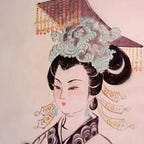Emperor Wu Zetian — the Only Woman to Ever Serve as China’s Emperor
Wu Zetian reigned during the Tang Dynasty and climbed from the role of Emperor’s Taizong’s concubine to becoming the Emperor herself.
After becoming Taizong’s concubine at age 14, she began turning the heads of many important men, including Taizong’s son, Prince Li Zhi. She began having an affair with him.
Though Taizong eventually died and Zetian was sent away to become a nun, Li Zhi, now taking his Emperor name, Gaozong brought her back, as he was madly in love with her.
Gaozong already had a wife, Lady Wang, who was not thrilled that he’d chosen a second concubine (she was already jealous of the first), especially since she was unable to have children of her own. His previous concubine had two children by him, but they were daughters.
Wu had a daughter, who was strangled in her crib soon after birth. Lady Wang happened to be the only person in the room without an alibi. Naturally, Wu accused her of committing the crime out of jealousy. She was exiled, leaving Wu free to become his wife.
Many historians speculate that it was actually Wu who killed her own daughter in order to frame Lady Wang and clear the path to marrying Gaozong. However, others dismiss this claim as being created to discredit a woman in power.
Wu began exercising her new power immediately, arguably acting as the Emperor long before her title was official. Wu did not understand why women should not be able to do the same things as men, and even took groups of women to perform rituals that only men were supposed to do.
Gaozong took ill and lost his eyesight, which meant all reports had to be read to him. Wu took this job gladly. He died in 683 CE.
Wu immediately put her son, Zhongzong, on the throne, but he would not obey her and his wife, Lady Wei took too much power away from her. Naturally she charged him with treason and had them both banished.
She then put her second son on the throne, Emperor Ruizong. Although she managed to confine him to the inner palace, he still did not live up to her expectations. She gave him no choice but to renounce the thrown, and place herself in power.
Now Emperor Zeitan, ruler of China, imprisoned all members of the Tang family. She organized her own police force and placed spies everywhere. Because of this, she was able to force anyone out of government office as she saw fit. She appointed her own choices in their place.
Wu even created 10–30 of her own Chinese characters into the writing system. She was known for listening to the suggestions of the people and implementing new systems to aid them. She reformed the education, agriculture, and military systems.
She re opened the Silk Road and reclaimed lands previously lost. Though once a dedicated ruler, she eventually became distracted with her young male lovers, which, as we know, the male Emperors always did with young women, but was unacceptable when the roles were reversed.
Wu became very paranoid, and started firing people left and right. She was eventually pushed out of rule, and her son, Zhongzong was reinstated. She died one year later, in 705 CE.
Her tomb can now be visited in Qian County, Shanxi Province. It has a slate that was intended to be filled with her accomplishments, but still remains blank. She is known as one of the greatest Chinese rulers to this day.
Though a controversial figure, under her rule, China saw a level of stability and affluence that it had not previously seen. She also laid the foundations that led to the success of future Emperors.
